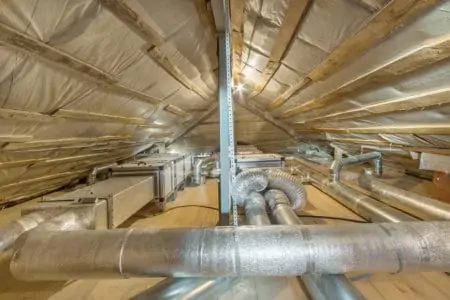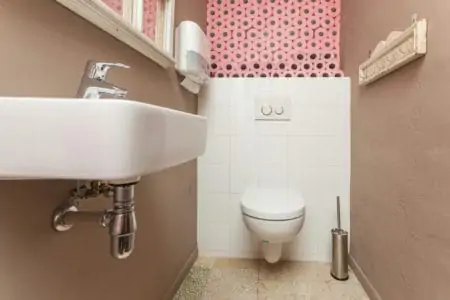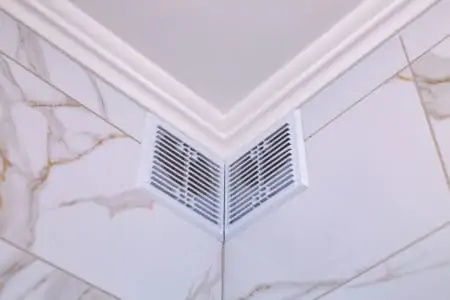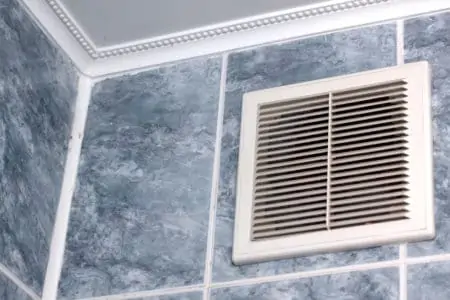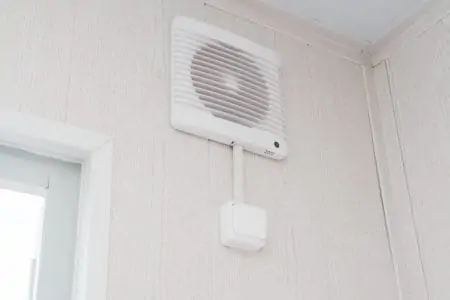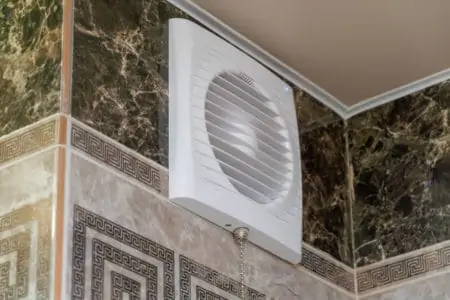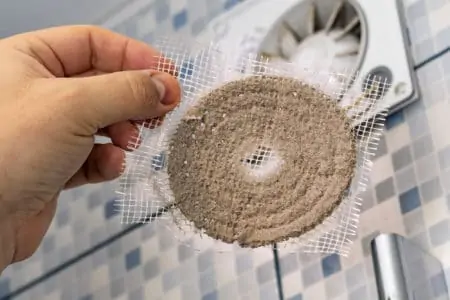Bathrooms need the correct ventilation. Poorly ventilated bathrooms can lead to all manner of issues. So, should you consider venting a bathroom fan into the attic?
We look at your options and give guidance so you can avoid crucial errors.
Key Takeaways
- Don’t vent bathroom fan into attic, as it causes mold and rot. Vent through a gable wall or roof instead.
- Building codes require proper ventilation, so follow guidelines and vent bathroom fan to the outside.
- Consider fan size, vent material, and duct length when installing a bathroom fan for optimal performance.
- Costs vary depending on installation type, but expect to pay around $200 for labor if venting through a gable wall.
Is It Okay To Vent a Bathroom Fan Into the Attic?
In short, no. You can vent a bathroom exhaust fan through the attic to the outside, but allowing steam and moisture to collect in the attic space leads to a whole heap of issues.
But why, we hear you ask? It was common practice in the 80s and 90s. Moisture and mold are very bad for wooden joists and rafters, insulation, cables, electrics, and any number of other things.
As moisture traps, wetness increases, allowing mold spores to form. This rots the wooden infrastructure of your roof, especially in the winter during colder spells, where the wood gets little opportunity to dry out.
Plus, as the air cools, moisture creates frost, which takes its toll on wooden beams. As the ice melts, the water drips onto the sheathing and drywall ceiling.
What Is the Building Code for Venting a Bathroom Fan?
The Environment Protection Agency (EPA) states that each bathroom must have a mechanical means of extracting moisture if there is no window that opens to provide ventilation.
The exhaust fan must have a CFM (Cubic Feet Per Minute) of 50 for intermittent operation and 20 CFM for continuous use. While model codes do not cover the configuration and direction of the vent system, they do publish guidelines that require the vents to exhaust to the outside.
- Residential code: R303 Ventilation air from the space shall be exhausted directly to the outside.
- Mechanical code: M1501.1 Outdoor discharge. The air removed by every mechanical exhaust system shall be discharged to the outside.
- M1507.2 Recirculation of air. Exhaust air from bathrooms and toilet rooms shall not be recirculated in a residence or to another dwelling unit and shall be exhausted directly to the outdoors.
How Do You Vent a Bathroom Fan Into the Attic?
We have established that venting a bathroom fan directly to the attic is against all building codes and a terrible idea, but where do you vent it to?
We’ve also learned that all expelled air must vent to the outdoors.
Where Should Bathroom Exhaust Fans Be Vented To?
The proper way to vent your bathroom fan should be through the roof or a cable end. The vent has to go directly outside. It has a small flap that opens when air is expelled but closes when it is dormant.
It prevents outside air from entering the home when the vent is off. It also prevents nesting birds from taking up residence in your ducting. It’s a good idea to install a vent roof cover to avoid this.
Can You Vent a Bathroom Fan Through a Gable Vent?
The correct way to vent a bathroom fan is through a gable vent with a hood cover to prevent outside air from escaping into the house when the fan is off. It is cheaper to do it this way than to put the vent through the roof as this requires a specialist roofer, which ramps up the costs.
How Far Can I Vent a Bathroom Fan?
This is an interesting question because there is no right or wrong answer. It depends on several factors.
- The fan size and CFM rating, or the design flow rate according to your local codes.
- The vent material (smooth or corrugated).
- The vent diameter.
- The number of elbows required along the duct length.
- The distance between the exhaust fan and the building’s exterior.
You should also consult the manufacturer’s manual to see what their recommendations are. As a rule of thumb, using a 4-inch diameter duct to carry the fan exhaust, the accepted maximum length is 25 feet.
How Much Does It Cost To Vent a Bathroom Fan Outside?
The smallest outlay is for the equipment and supplies. You should expect to pay somewhere around $70 for a 25 ft insulated bathroom vent. Next comes the labor costs. If you opt for a DIY approach, this reduces the price considerably.
If you vent to the roof, you will need a roofer, adding to the overall budget. Plus, roof vents are more complicated to install. Expect to pay anywhere between $500 and $750 in labor costs alone.
Going through a gable wall is considerably cheaper, reducing the price to about $200 for labor. Your best course of action is to get a couple of quotes and then decide.
How Do You Vent a Bathroom Fan With No Outside Access?
Venting a bathroom fan without outside access requires some imagination. First, you could locate the fan on the floor and run the ducting between the floor joints to an exterior wall. This would require a fan strong enough to get the moisture to the outside.
Second, you could install a recirculating fan, especially if you have low levels of bathroom moisture. The fan pushes air through a filter, making it better at removing odors.
Third, if you live in an apartment block with high ceilings, commercial ducting could be the solution. It could be fed to the nearest outside wall and disguised using a soffit.
To help increase the airflow, install a small grill under the bathroom door. This helps to draw air from the rest of the house to dissipate moisture.
FAQs
Vent Like a Pro
Moisture inside your home is inevitable. It happens when we shower, wash our hands, cook, and even breathe. Removing the wet air is necessary to avoid dampness, mold, mildew, and harmful pollutants circulating around our homes.
Bathroom fans are crucial in this battle, so how and where you fit it matters. Get it right the first time, and you save a whole heap of agony later.
